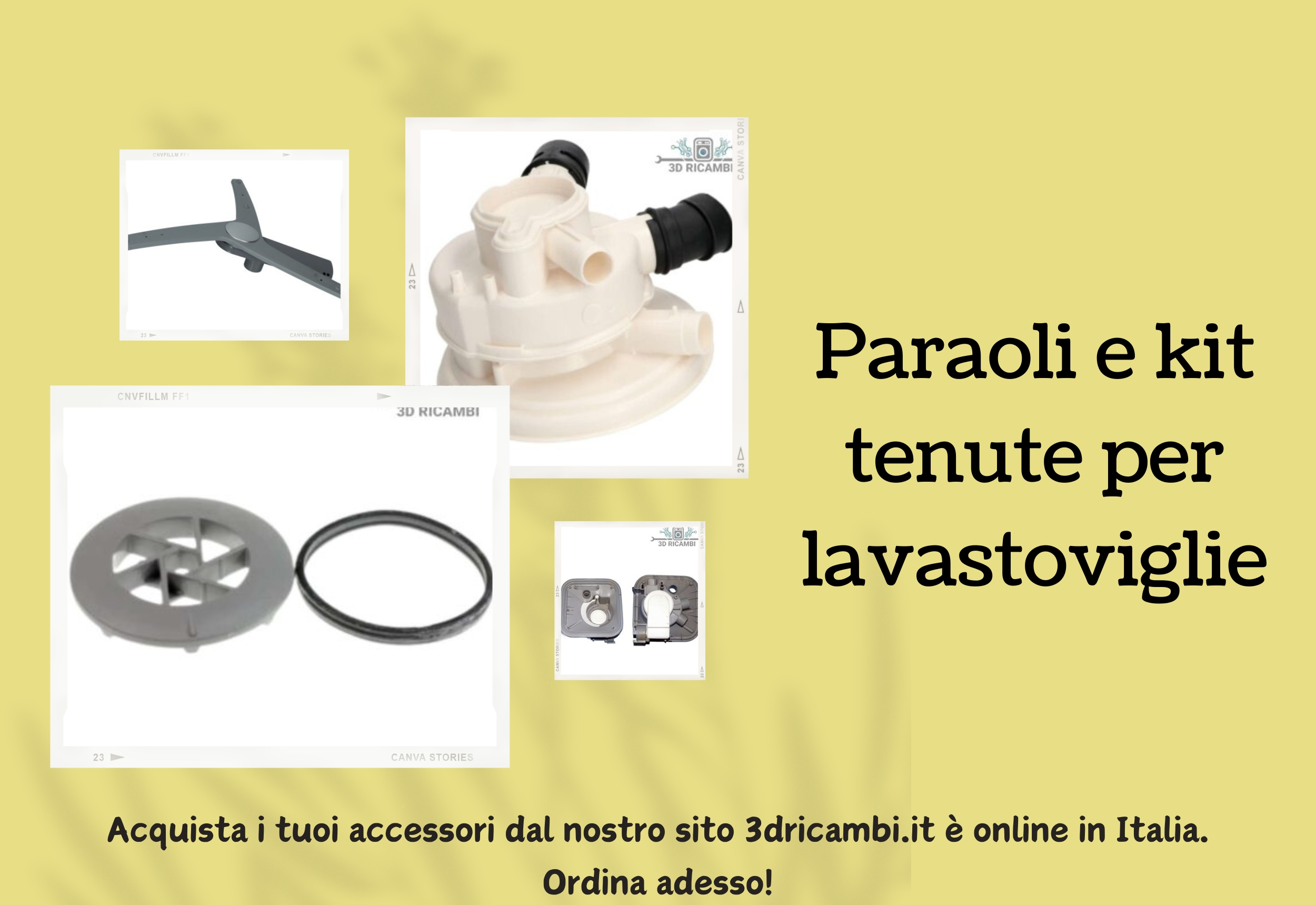Paraoli e Kit Tenute per Lavastoviglie: Guida Completa

Introduction
Dishwasher oil seals and seal kits are essential components to ensure the correct functioning and durability of your appliance. These elements play a crucial role in preventing water leaks and ensuring that all moving parts work smoothly. In this article, we’ll explore the importance of oil seals and seal kits, how to keep them in good shape, and when to replace them. We will also offer practical advice to extend the life of your dishwasher.
What is an Oil Seal?
Definition and Function
The oil seal is a sealing ring that prevents liquids from leaking from the moving components of the dishwasher. It is made of rubber or other elastomeric materials resistant to chemicals and high temperatures.
What is a Seal Kit?
Definition and Function
A seal kit includes various sealing components, such as gaskets, sealing rings and O-rings, designed to seal different parts of the dishwasher. These components work together to prevent leaks and maintain the integrity of your dishwasher’s plumbing system.
Why Are Oil Seals and Seal Kits Important?
Prevention of Water Leaks
Oil seals and seal kits are essential to prevent water from leaking from the internal components of the dishwasher, preventing damage to the floor and surrounding appliances.
Efficient Operation
Ensuring an airtight seal allows the dishwasher’s plumbing system to function optimally, improving cleaning efficiency and reducing energy and water consumption.
Extending the Life of the Appliance
Keeping oil seals and seals in good condition helps prevent damage to your dishwasher’s internal components, extending its life and reducing the need for costly repairs.
Types of Oil Seals and Seal Kits for Dishwasher
Oil Seals for Pump
These oil seals seal the moving parts of your dishwasher pump, preventing water from leaking and protecting the internal components from corrosion.
Sealing rings
Grommets are used to seal the joints between pipes and fittings, ensuring there are no leaks along the plumbing system.
O-Rings
O-rings are small rubber rings used to seal connections between different parts of the dishwasher. They are essential to prevent leaks at critical points.
Specialized seals
These gaskets are designed for specific applications within the dishwasher, such as sealing the engine or valves.
How to Keep Oil Seals and Seals in Good Condition
Regular cleaning
Cleaning the inside of your dishwasher regularly helps prevent the buildup of residue that can damage oil seals and seals.
Periodic Inspections
Eseguire ispezioni periodiche delle tenute per verificare la presenza di segni di usura o danni. Intervenire tempestivamente può prevenire problemi maggiori.
Lubrificazione
Applicare un lubrificante specifico per tenute può aiutare a mantenere i paraoli flessibili e prevenire crepe o rotture.
Quando Sostituire i Paraoli e le Tenute per Lavastoviglie
Segnali di Usura
Se noti perdite d’acqua, rumori insoliti o una diminuzione dell’efficienza della lavastoviglie, è probabile che i paraoli o le tenute siano usurati e debbano essere sostituiti.
Perdite d’Acqua
Qualsiasi segno di perdite d’acqua è un’indicazione chiara che uno o più componenti di tenuta potrebbero essere danneggiati e necessitano di sostituzione.
Danni Visibili
Se durante un’ispezione visiva noti crepe, tagli o deformazioni nei paraoli o nelle tenute, è il momento di sostituirli.
Come Sostituire i Paraoli e le Tenute per Lavastoviglie
Passo 1: Acquisto del Kit Tenute
Assicurati di acquistare un kit tenute compatibile con il modello della tua lavastoviglie. Consulta il manuale dell’utente o contatta il produttore per informazioni specifiche.
Passo 2: Rimozione dei Vecchi Paraoli e Tenute
Scollega la lavastoviglie dalla rete elettrica e dall’alimentazione dell’acqua. Smonta i componenti necessari per accedere ai paraoli e alle tenute usurati.
Passo 3: Pulizia delle Superfici di Montaggio
Pulire accuratamente le superfici di montaggio per rimuovere residui e garantire una buona adesione dei nuovi componenti di tenuta.
Passo 4: Installazione dei Nuovi Paraoli e Tenute
Installa i nuovi paraoli e tenute seguendo le istruzioni del manuale dell’utente. Assicurati che siano ben posizionati e che non ci siano pieghe o deformazioni.
Passo 5: Test di Funzionamento
Ricollega la lavastoviglie e esegui un ciclo di prova per assicurarti che i nuovi paraoli e tenute funzionino correttamente e che non ci siano perdite d’acqua.
Consigli per Prolungare la Vita dei Paraoli e delle Tenute
Evita Detergenti Aggressivi
L’uso di detergenti aggressivi può danneggiare i paraoli e le tenute. Opta per detergenti specifici per lavastoviglie che siano delicati sui componenti.
Manutenzione Regolare
Eseguire una manutenzione regolare della lavastoviglie, inclusa la pulizia e l’ispezione delle tenute, aiuta a prevenire problemi maggiori e a mantenere l’elettrodomestico in buone condizioni.
Riparazioni Tempestive
Intervenire tempestivamente in caso di perdite o problemi aiuta a prevenire danni più gravi e costosi.
Innovazioni nei Paraoli e Kit Tenute per Lavastoviglie
Materiali Avanzati
I nuovi paraoli e kit tenute sono realizzati con materiali avanzati, come il silicone e il PTFE, che offrono una maggiore resistenza alle alte temperature e agli agenti chimici.
Design Ergonomico
The design of the new seals facilitates installation and ensures better adhesion, reducing the risk of water leaks.
Self-cleaning functions
Some modern seal kits include components with self-cleaning properties that help keep the inside of the dishwasher clean and prevent residual buildup.
Conclusion
Dishwasher oil seals and seal kits are essential components to ensure the correct functioning and longevity of your appliance. Understanding the importance of these components, knowing how to maintain them and when to replace them, and adopting good maintenance practices can make the difference between a dishwasher that works perfectly and one that requires frequent repairs. Investing time in caring for your dishwasher’s oil seals and seals will allow you to enjoy perfectly clean dishes and prolong the life of your appliance.
FAQs
How often should I inspect my dishwasher’s oil seals and seals?
It is advisable to inspect oil seals and seals at least once every six months to prevent major problems.
How can I tell if my dishwasher oil seals are damaged?
Signs of damaged oil seals include water leaks, unusual noises during the wash cycle, and a decrease in the efficiency of the dishwasher.
Can I replace my dishwasher’s oil seals and seals myself?
Yes, with the right tools and following the manufacturer’s manual instructions, you can replace oil seals and seals yourself. If you feel unsure, it is advisable to contact a professional technician.

Leave a Comment